Energy and Economic Evaluation of Green Roofs for Residential Buildings in Hot-Humid Climates
Abstract
:1. Introduction
- Develop a green roof model for a selected four bedroom residential building with the help of DesignBuilder software.
- Validate the result of the developed model using experimental data.
- Determine the energy saving potential of different green roof options.
- Undertake economic assessment of the developed green roof.
2. Overview of Green Roof Technology
3. Energy Challenges Facing Saudi Arabia
4. Green Roof Model Development
4.1. Validation of the Model
5. Simulation Techniques for Energy Analysis
6. Economic Evaluation
- t is the time period, usually computed yearly.
- Ft the net cash flow for year t, computed as Ft = Bt − Ct.
- Bt represents the inflows or benefits accrued for the year t (which in this study is taken as the cost of Energy-savings in year t and the cost of other potential benefits).
- Ct represents the cost outflows for year t (which in this study is taken as the total operations and maintenance cost for year t).
- C0 represents the initial investment (including all costs of materials and installation).
- p the cost of capital taken as 2% (Source): [50].
- n is the number of years for which the economic evaluation is desired (40 years for this study).
7. Results and Discussion
7.1. Energy Analysis
7.2. Economic Analysis
8. Conclusions
Acknowledgment
Author Contributions
Conflicts of Interest
References
- Mujeebu, M.A.; Alshamrani, O.S. Prospects of energy conservation and management in buildings–The Saudi Arabian scenario versus global trends. Renew. Sustain. Energy Rev. 2016, 58, 1647–1663. [Google Scholar] [CrossRef]
- Suganthi, L.; Samuel, A.A. Energy models for demand forecasting—A review. Renew. Sustain. Energy Rev. 2012, 16, 1223–1240. [Google Scholar] [CrossRef]
- Asif, M. Urban Scale Application of Solar PV to Improve Sustainability in the Building and the Energy Sectors of KSA. Sustainability 2016, 8. [Google Scholar] [CrossRef]
- Muneer, T.; Asif, M.; Cizmecioglu, Z.; Ozturk, H.K. Prospects for solar water heating within Turkish textile industry. Renew. Sustain. Energy Rev. 2008, 12, 807–823. [Google Scholar] [CrossRef]
- Asif, M.; Muneer, T. Energy supply, its demand and security issues for developed and emerging economies. Renew. Sustain. Energy Rev. 2007, 11, 1388–1413. [Google Scholar] [CrossRef]
- Terés-Zubiaga, J.; Campos-Celador, A.; González-Pino, I.; Escudero-Revilla, C. Energy and economic assessment of the envelope retrofitting in residential buildings in Northern Spain. Energy Build. 2015, 86, 194–202. [Google Scholar] [CrossRef]
- Asif, M. Energy Crisis in Pakistan: Origins, Challenges, and Sustainable Solutions; Oxford University Press: Karachi, Pakistan, 2012. [Google Scholar]
- UNEP SBCI. Buildings and Climate Change: Summary for Decision-Makers; United Nations Environmental Programme, Sustainable Buildings and Climate Initiative: Paris, France, 2009. [Google Scholar]
- Alnaser, N.W.; Flanagan, R.; Alnaser, W.E. Model for calculating the sustainable building index (SBI) in the kingdom of Bahrain. Energy Build. 2008, 40, 2037–2043. [Google Scholar] [CrossRef]
- Asif, M. Growth and sustainability trends in the buildings sector in the GCC region with particular reference to the KSA and UAE. Renew. Sustain. Energy Rev. 2016, 55, 1267–1273. [Google Scholar] [CrossRef]
- U.S Green Building Council. LEED Reference Guide for Green Building Design and Construction. Available online: http://www.usgbc.org/resources/leed-reference-guide-green-building-design-and-construction-global-acps (accessed on 12 January 2016).
- Fowler, K.M.; Rauch, E.M. Sustainable Building Rating Systems Summary; No. PNNL-15858; Pacific Northwest National Laboratory (PNNL): Richland, WA, USA, 2006. [Google Scholar]
- Iwaro, J.; Mwasha, A. The impact of sustainable building envelope design on building sustainability using Integrated Performance Model. Int. J. Sustain. Built Environ. 2013, 2, 153–171. [Google Scholar] [CrossRef]
- Alnatheer, O. The potential contribution of renewable energy to electricity supply in Saudi Arabia. Energy Policy 2005, 33, 2298–2312. [Google Scholar] [CrossRef]
- Al-Saleh, Y. Renewable energy scenarios for major oil-producing nations: The case of Saudi Arabia. Futures 2009, 41, 650–662. [Google Scholar] [CrossRef]
- Hepbasli, A.; Alsuhaibani, Z. A key review on present status and future directions of solar energy studies and applications in Saudi Arabia. Renew. Sustain. Energy Rev. 2011, 15, 5021–5050. [Google Scholar] [CrossRef]
- Iqbal, M.T. A feasibility study of a zero energy home in Newfoundland. Renew. Energy 2004, 29, 277–289. [Google Scholar] [CrossRef]
- Passive Design Toolkit for Homes. Available online: http://vancouver.ca/home-propertydevelopment/passive-design-guidelines.aspx (accessed on 23 May 2015).
- Jaffal, I.; Ouldboukhitine, S.E.; Belarbi, R. A comprehensive study of the impact of Green Roofs on building energy performance. Renew. Energy 2012, 43, 157–164. [Google Scholar] [CrossRef]
- Santamouris, M.; Pavlou, C.; Doukas, P.; Mihalakakou, G.; Synnefa, A.; Hatzibiros, A.; Patargias, P. Investigating and analysing the energy and environmental performance of an experimental green roof system installed in a nursery school building in Athens, Greece. Energy 2007, 32, 1781–1788. [Google Scholar] [CrossRef]
- Sfakianaki, A.; Pagalou, E.; Pavlou, K.; Santamouris, M.; Assimakopoulos, M.N. Theoretical and experimental analysis of the thermal behaviour of a green roof system installed in two residential buildings in Athens, Greece. Int. J. Energy Res. 2009, 33, 1059–1069. [Google Scholar] [CrossRef]
- Silva, C.M.; Gomes, M.G.; Silva, M. Green roofs energy performance in Mediterranean climate. Energy Build. 2016, 116, 318–325. [Google Scholar] [CrossRef]
- Li, X.X.; Norford, L.K. Evaluation of cool roof and vegetations in mitigating urban heat island in a tropical city, Singapore. Urban Clim. 2016, 16, 59–74. [Google Scholar]
- Bevilacqua, P.; Mazzeo, D.; Bruno, R.; Arcuri, N. Experimental investigation of the thermal performances of an extensive green roof in the Mediterranean area. Energy Build. 2016, 122, 63–79. [Google Scholar] [CrossRef]
- Spala, A.; Bagiorgas, H.S.; Assimakopoulos, M.N.; Kalavrouziotis, J.; Matthopoulos, D.; Mihalakakou, G. On the green roof system. Selection, state of the art and energy potential investigation of a system installed in an office building in Athens, Greece. Renew. Energy 2008, 33, 173–177. [Google Scholar] [CrossRef]
- Bates, A.J.; Sadler, J.P.; Mackay, R. Vegetation development over four years on two green roofs in the UK. Urban For. Urban Green. 2013, 12, 98–108. [Google Scholar] [CrossRef]
- Carter, T.; Butler, C. Ecological impacts of replacing traditional roofs with green roofs in two urban areas. Cities Environ. (CATE) 2008, 1, 9. [Google Scholar] [CrossRef]
- Williams, N.S.; Rayner, J.P.; Raynor, K.J. Green roofs for a wide brown land: Opportunities and barriers for rooftop greening in Australia. Urban For. Urban Green. 2010, 9, 245–251. [Google Scholar] [CrossRef]
- Wong, N.H.; Cheong, D.W.; Yan, H.; Soh, J.; Ong, C.L.; Sia., A. The effect of roof top garden on energy consumption ofa commercial building in Singapore. Energy Build. 2003, 35, 353–364. [Google Scholar]
- Alrashed, F.; Asif, M. Trends in residential energy consumption in Saudi Arabia with particular reference to the Eastern Province. J. Sustain. Dev. Energy Water Environ. Syst. 2014, 2, 376–387. [Google Scholar]
- Alrashed, F.; Asif, M. Analysis of critical climate related factors for the application of zero-energy homes in Saudi Arabia. Renew. Sustain. Energy Rev. 2015, 41, 1395–1403. [Google Scholar] [CrossRef]
- International Green Roof Association IGRA. Available online: http://www.igra-world.com/ (accessed on 1 March 2015).
- Ouldboukhitine, S.E.; Belarbi, R.; Jaffal, I.; Trabelsi, A. Assessment of green thermal behavior: A couple heat and mass transfer model. Build. Environ. 2011, 46, 2624–2631. [Google Scholar] [CrossRef]
- Gallardo, N.P.; de Figueiredo Neves, G.Z.; Tech, A.R.B. Thermal Response to Heat in Buildings with Green Covers for Tropical Climate: Green Facades and Green Roofs. J. Civ. Eng. Archit. 2016, 10, 919–931. [Google Scholar]
- Teemusk, A.; Mander, U. Temperature rigime of planted roofs compared with convention roofing systems. Ecol. Eng. 2010, 36, 91–95. [Google Scholar] [CrossRef]
- Saadattian, O.; Sopian, K.; salleh, E.; Lim, C.H.; Riffat, S.; Saadatian, E.; Toudeshki, A.; Sulaiman, M.Y. A review of energy aspect of Green Roof. Renew. Sustain. Energy Rev. 2013, 23, 155–168. [Google Scholar] [CrossRef]
- Fioretti, R.; Palla, A.; Lanza, L.G.; Principi, P. Green Roof energy and water related performance in the Mediterranean climate. Build. Environ. 2010, 45, 1890–1904. [Google Scholar] [CrossRef]
- Jim, C.Y. Air-conditioning energy consumption due to green roofs with different building thermal insulation. Appl. Energy 2014, 128, 49–59. [Google Scholar] [CrossRef]
- Goussous, J.; Siam, H.; Alzoubi, H. Prospect of green roof technology for energy and thermal benefits in buildings: Case study of Jordan. Sustain. Cities Soc. 2014, 192, 1–16. [Google Scholar] [CrossRef]
- Kamel, B.; Wahiba, S.; Nassar, K.; Abdelsalam, A. Effectiveness of green roof on reduction of energy consumption through simulation program for a residential building: Cairo, Egypt. In Proceedings of the Construction Research Congress, West Lafayette, Indiana, 21–23 May 2012. [Google Scholar]
- Qin, X.; Wu, X.; Chiew, Y.M.; Li, Y. A Green Roof Test Bed for Stormwater Management and Reduction of Urban Heat Island Effect in Singapore. Br. J. Environ. Clim. Chang. 2012, 2, 410–420. [Google Scholar] [CrossRef] [PubMed]
- Dunnett, N.; Nolan, A. The effect of substrate depth and supplementary watering on the growth of nine herbaceous perennials in a semi-extensive Green Roof. Acta Hortic. 2004. [Google Scholar] [CrossRef]
- Nagase, A.; Dunnett, N. Drought tolerance in different vegetation types for extensive green roofs: Effects of watering and diversity. Landsc. Urban Plan. 2010, 97, 318–327. [Google Scholar] [CrossRef]
- Feitosa, R.C.; Wilkinson, S. Modelling green roof stormwater response for different soil depths. Landsc. Urban Plan. 2016, 153, 170–179. [Google Scholar] [CrossRef]
- Sims, A.W.; Robinson, C.E.; Smart, C.C.; Voogt, J.A.; Hay, G.J.; Lundholm, J.T.; Powers, B. O’Carroll, D.M. Retention performance of green roofs in three different climate regions. J. Hydrol. 2016, 542, 115–124. [Google Scholar] [CrossRef]
- Saudi Electricity Company Annual Report 2011. Available online: https://www.se.com.sa/en-us/Pages/AnnualReports.aspx (accessed on 10 December 2014).
- Saudi Energy Efficiency Center. Available online: http://www.seec.gov.sa/en (accessed on 15 December 2015).
- Sailor, D.J. A green roof model for building energy simulation programs. Energy Build. 2008, 40, 1466–1478. [Google Scholar] [CrossRef]
- Au, T.; Au, T.P. Engineering Economics for Capital Investment Analysis; Allyn and Bacon: Newton, MA, USA, 1983. [Google Scholar]
- SAMA. SAMA Repo Rate, Interest Rate Central Bank Saudi Arabia. Available online: http://www.global-rates.com/interest-rates/central-banks/central-bank-saudi-arabia/sama-interest-rate.aspx (accessed on 11 April 2016).
- SEC. Saudi Electricity Company (SEC) Consumption Tariff. Available online: https://www.se.com.sa/en-us/Customers/Pages/TariffRates.aspx (accessed on 11 April 2016).
- Acks, K. A framework for cost-benefit analysis of green roofs: Initial estimates. Available online: http://ccsr.columbia.edu/cig/greenroofs/green_roof_cost_benefit_analysis.pdf (accessed on 15 April 2015).
- Kosareo, L.; Ries, R. Life Cycle Assessment of a green roof in Pittsburgh. In Proceedings of the Fourth North American Green Roof Conference: Greening Rooftops for Sustainable Communities, Boston, MA, USA, 11–12 May 2006. [Google Scholar]
- Clark, C.; Adriaens, P.; Talbot, F.B. Green Roof Valuation: A Probabilistic Economic Analysis of Environmental Benefits. Environ. Sci. Technol. 2008, 42, 2155–2161. [Google Scholar] [CrossRef] [PubMed]
- Ulubeyli, S.; Arslan, V. Economic viability of extensive green roofs through scenario and sensitivity analyses: Clients’ perspective. Energy Build. 2017, 139, 314–325. [Google Scholar] [CrossRef]
- McRae, A.M. Case study: A conservative approach to green roof benefit quantification and valuation for public buildings. Eng. Econ. 2016, 61, 190–206. [Google Scholar] [CrossRef]
- Yang, J.; Yu, Q.; Gong, P. Quantifying Air Pollution Removal by Green Roofs in Chicago. Atmos. Environ. 2008, 42, 7266–7273. [Google Scholar] [CrossRef]
- Schrader, S.; Böning, M. Soil formation on green roofs and its contribution to urban biodiversity with emphasis on Collembolans. Pedobiologia 2006, 50, 347–356. [Google Scholar] [CrossRef]
- Akbari, H.; Pomerantz, M.; Taha, H. Cool surfaces and shade trees to reduce energy use and improve air quality in urban areas. Sol. Energy 2001, 70, 295–310. [Google Scholar] [CrossRef]
- Jung, Y.; Yeo, K.; Oh, J.; Lee, S.; Park, J.; Song, C.G. The economic effect of green roofs on non-point pollutant sources management using the replacement cost approach. KSCE J. Civ. Eng. 2016, 20, 3031–3044. [Google Scholar] [CrossRef]
- Zinzi, M.; Agnoli, S. Cool and Green Roofs. An energy and comfort comparison between passive cooling and mitigation urban heat island techniques for residential buildings in the Mediterranean region. Energy Build. 2012, 55, 66–76. [Google Scholar] [CrossRef]
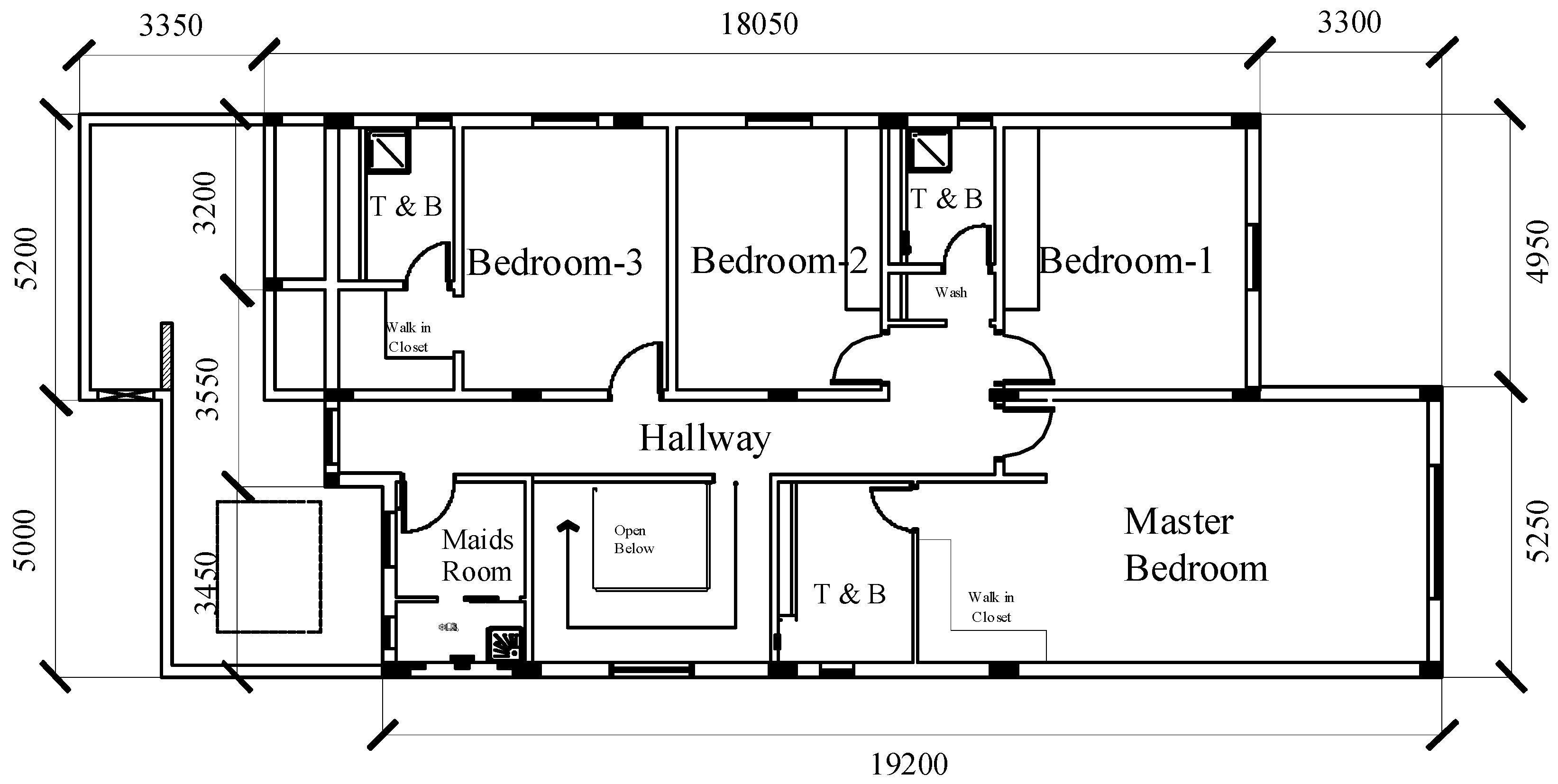
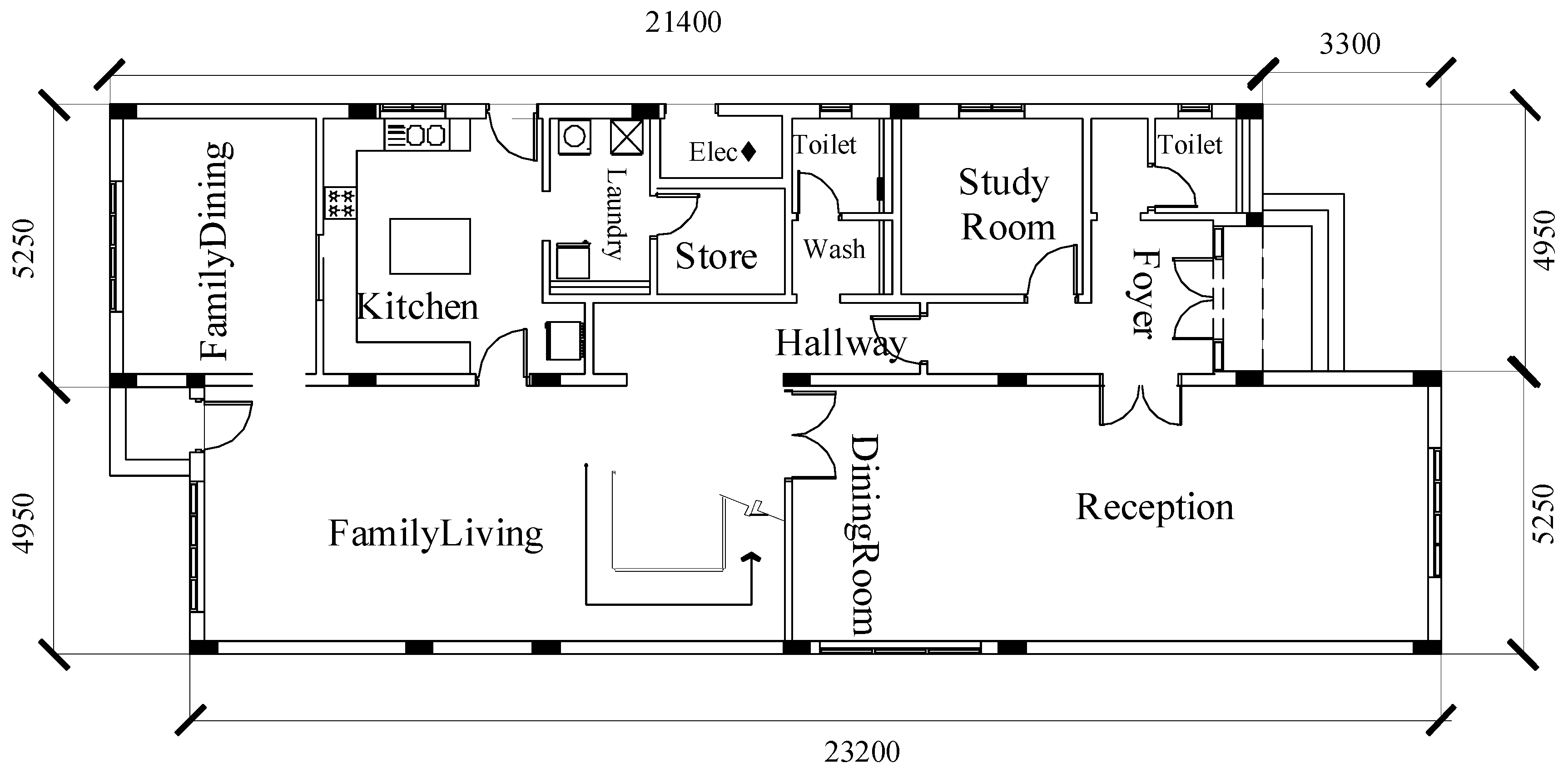
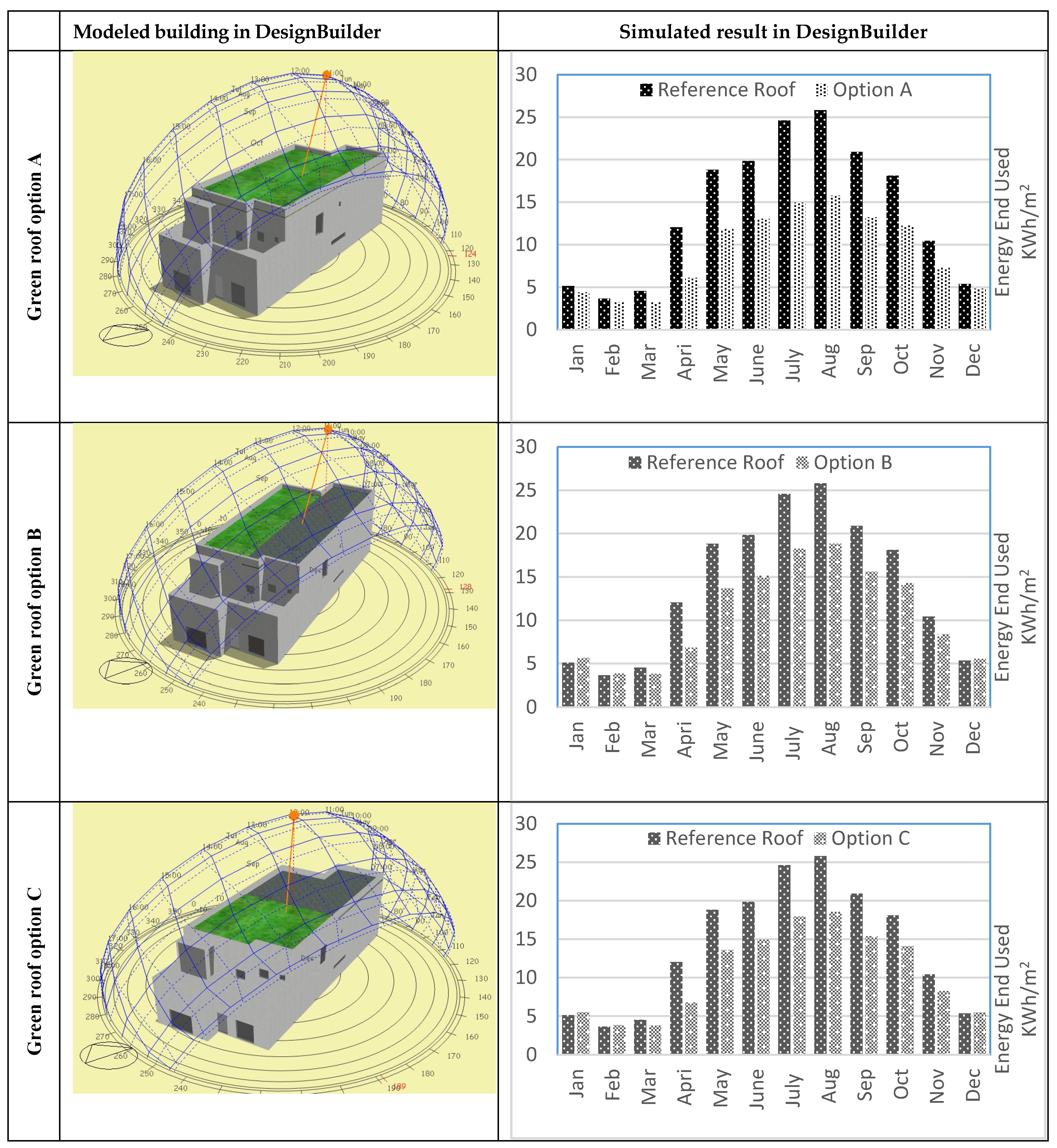
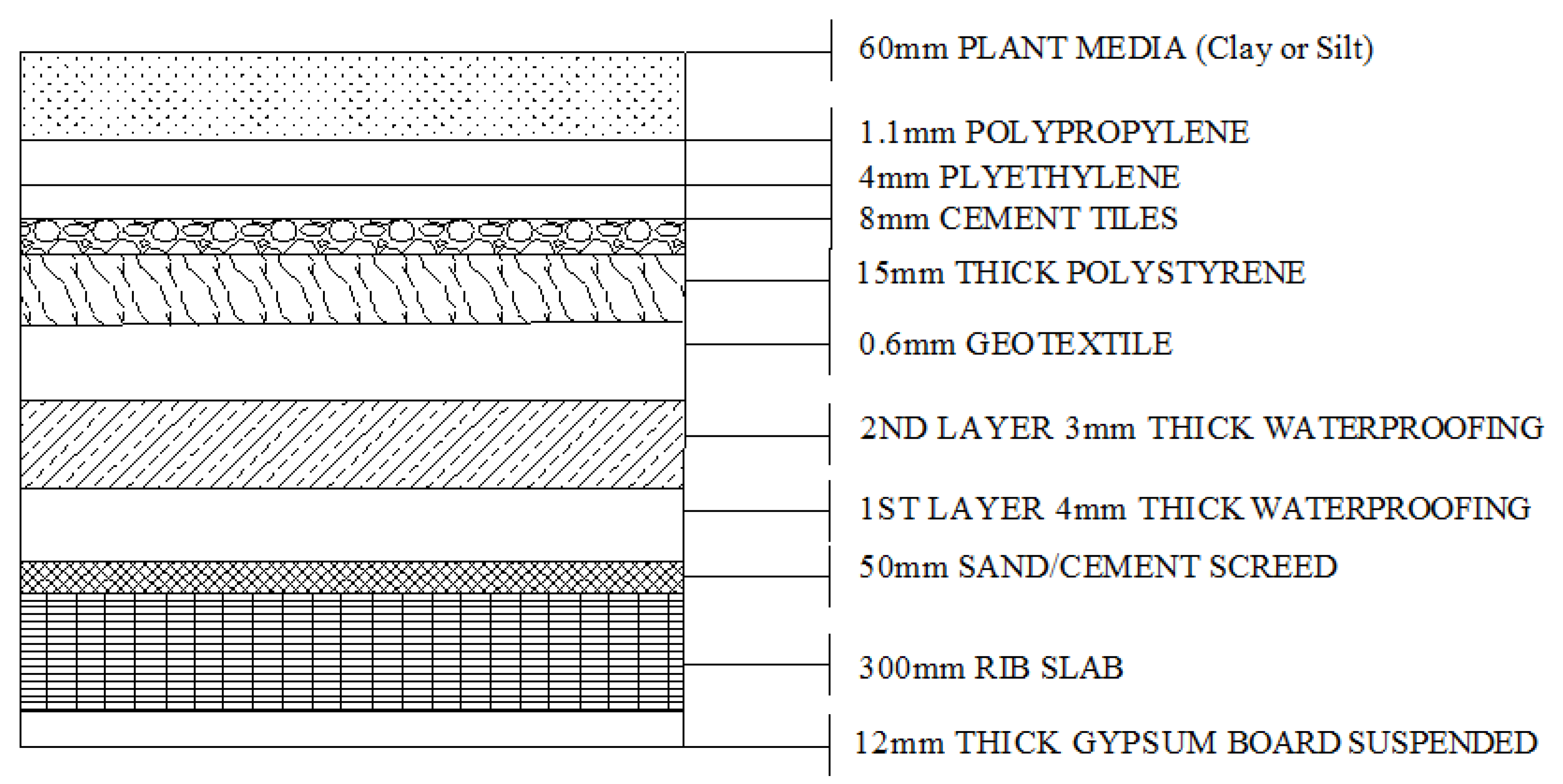
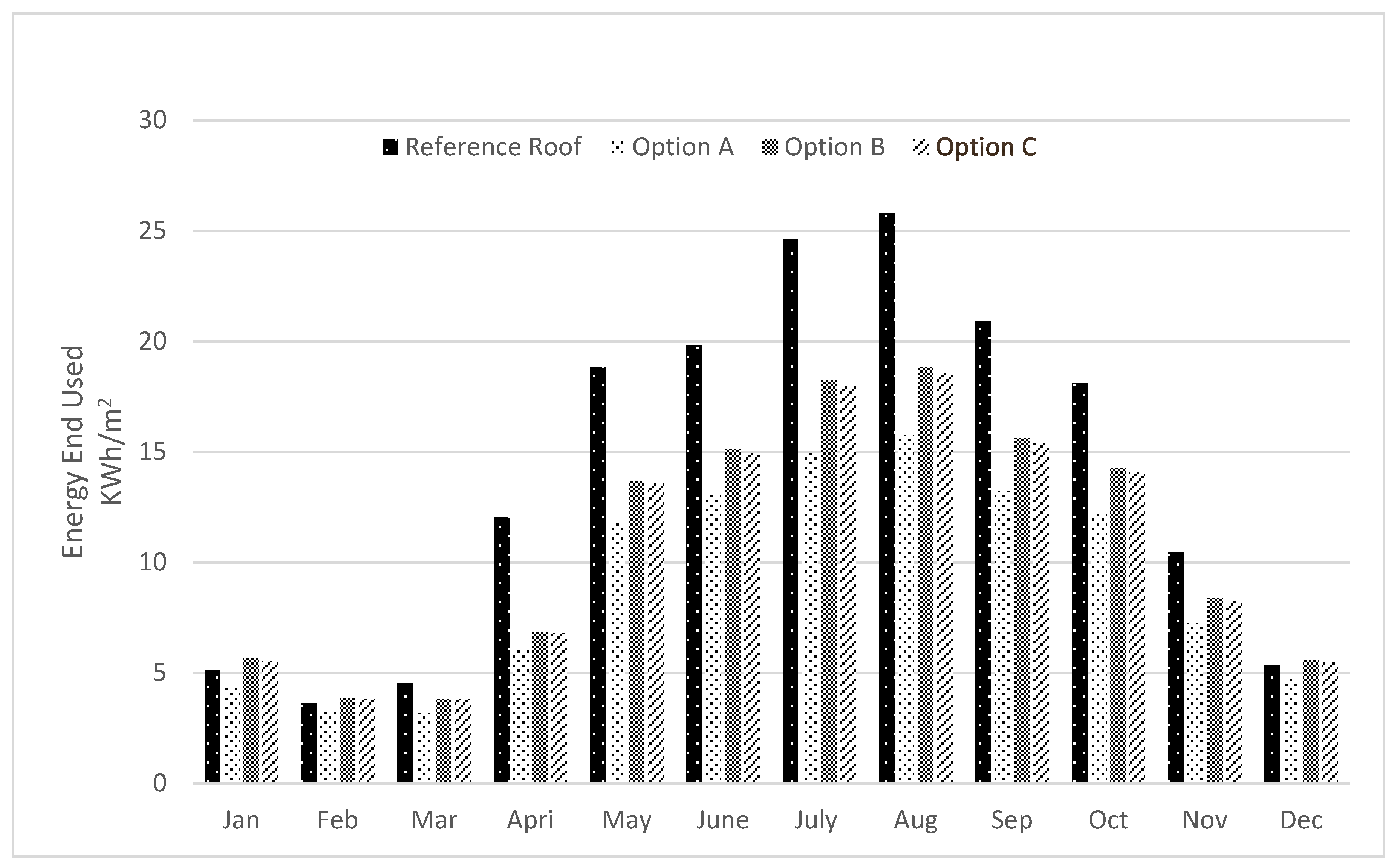
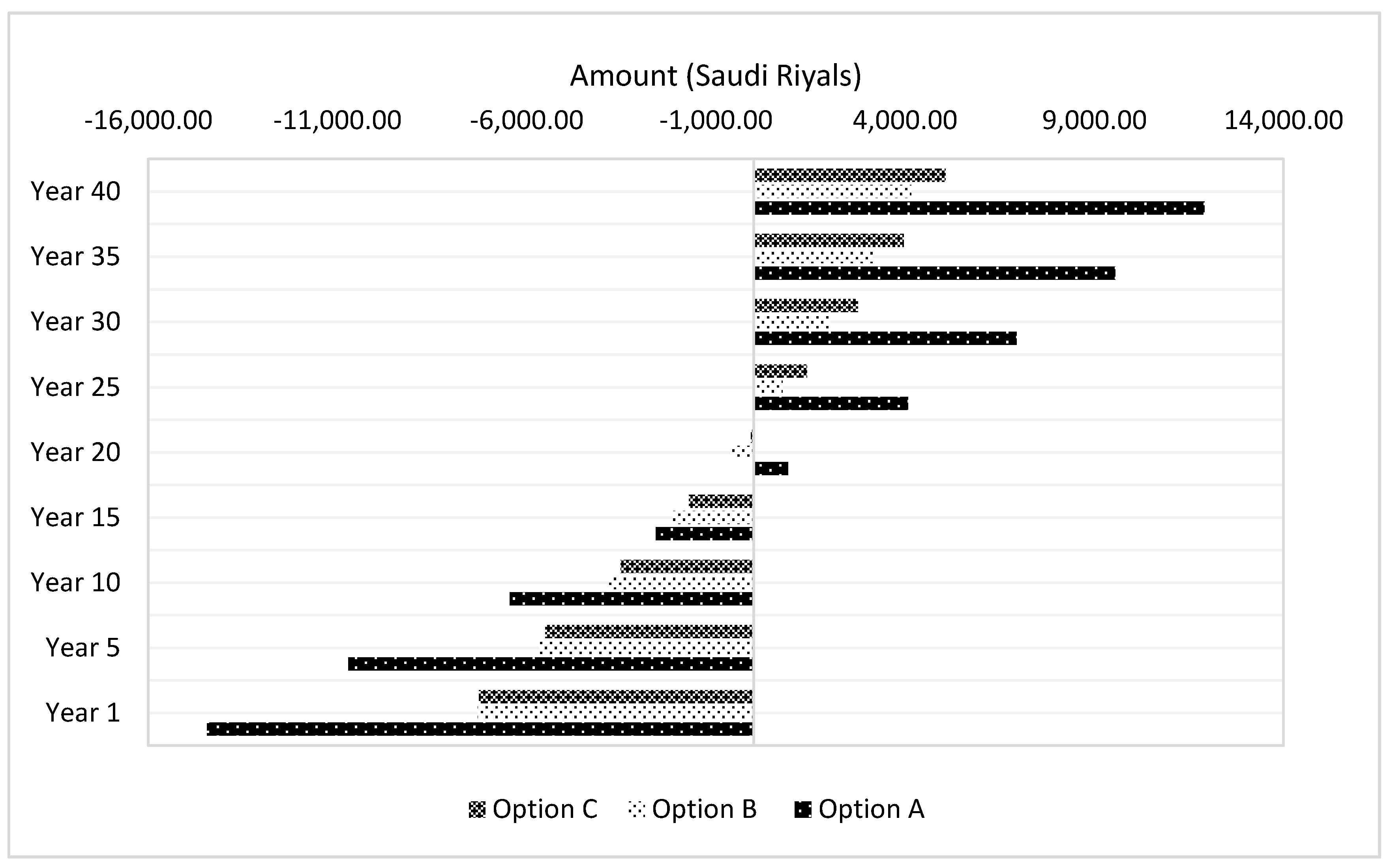
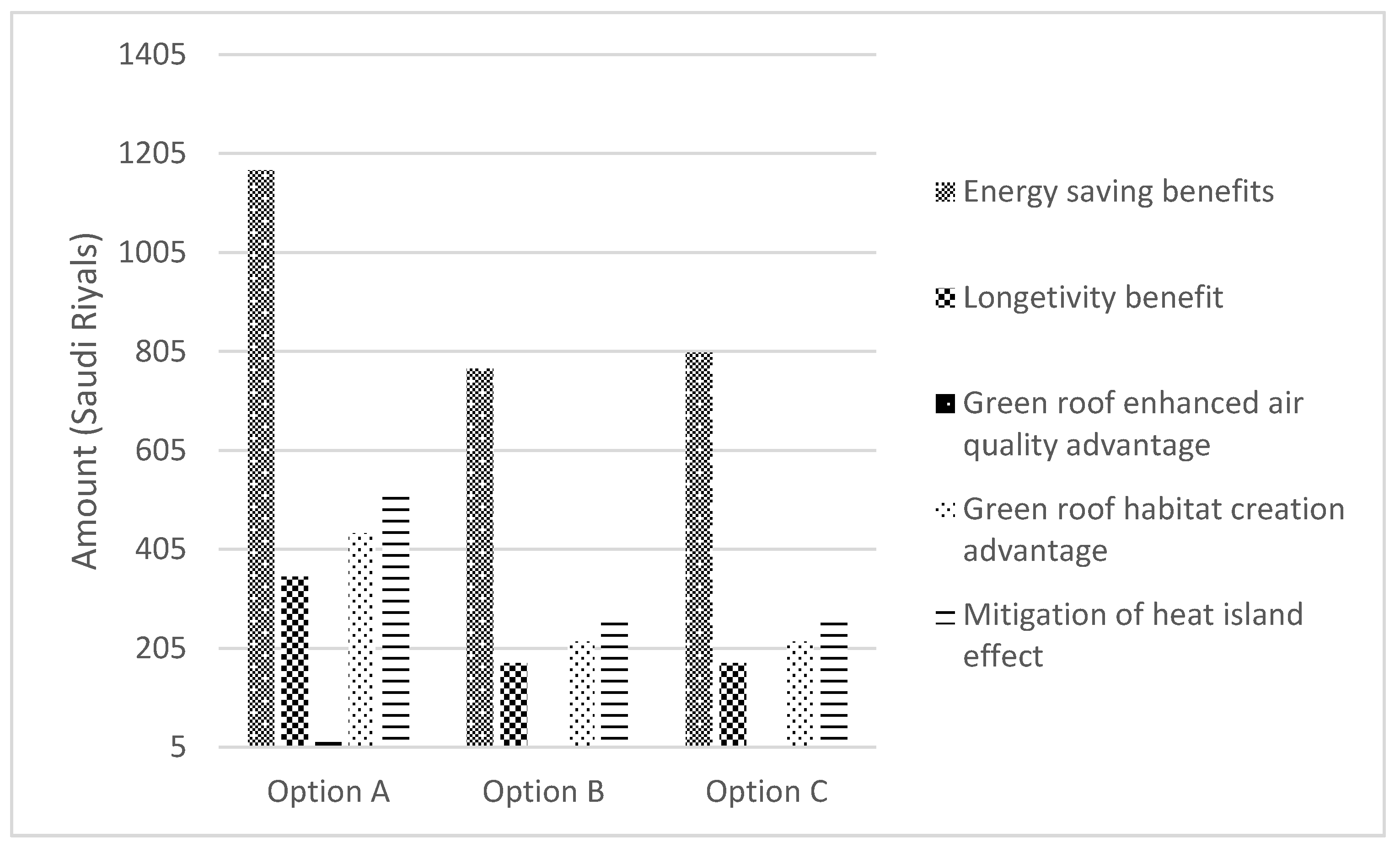
| Building Features | Description of the Housing |
|---|---|
| Location | Dhahran (26.27 N latitude, 50.15 E longitude, and 17 m above sea level) |
| Orientation | Front Elevation facing East |
| Floor to Floor Height | 3.5 m |
| Occupancy Density | 8 |
| Floor Area | 367.3 m2 (Gross); 192.0 m2 (Ground Floor); 175.0 m2 (First Floor) |
| Window to Wall Ratio (WWR) | 10% |
| Weather File and relative humidity (RH) | Dhahran: 2012 and 55% relative humidity |
| Exterior Walls | 0.016 m Plaster (Dense) + 0.1 m Concrete Block (Medium) + 0.05 m Extruded Polystyrene + 0.1 m Concrete Block (Medium) + 0.013 m Plaster (Lightweight) |
| Roof | 0.04 m Concrete Tiles (Roofing) + 0.0002 m Polyethylene (High Density) + 0.05 m Extruded Polystyrene + 0.004 m Bitumen Felt + 0.059 m Cement Screed + 0.3 m Reinforced Concrete (Cast, Dense) |
| Infiltration | 1.25 air changes per hour (ACH) (Ground Floor), 0.75 ACH (First Floor) |
| Lighting Power Density | 21 W/m2 (Ground Floor); 13 W/m2 (First Floor) |
| Heating, ventilation, and air conditioning (HVAC) System Type | Residential System Direct Expansion (DX) Air Conditioner (AC) |
| Window | 0.004 m tinted glass +0.012 m air gap + 0.004 m tinted glass |
| Month | Measured Data KWh/m2 | Simulated Data KWh/m2 |
|---|---|---|
| July | 25.8 | 24.6 |
| August | 28.1 | 25.8 |
| September | 23.8 | 20.9 |
| Total | 77.7 | 71.3 |
| No. | Properties | Value |
|---|---|---|
| 1 | Thermal Conductivity (W/(m·K)) | 0.30 |
| 2 | Height of Plants (m) | 0.30 |
| 3 | Leaf Area Index (LAI) | 5.00 |
| 4 | Leaf Reflectivity | 0.40 |
| 5 | Leaf Emissivity | 0.95 |
| 6 | Minimum Stomata Resistance (s/m) | 50.0 |
| 7 | Maximum Volumetric Moisture Content at Saturation | 0.50 |
| 8 | Minimum Residual Volumetric Moisture Content | 0.20 |
| Variable | Value | Source |
|---|---|---|
| Installation cost for extensive green roofs (including the soil and equipment needed) | SR 88 per square meter | Local practitioners |
| Annual operations and maintenance cost | Varies | Local practitioners |
| Saudi energy consumption tariff | SR 0.113 /KWh | [51] |
| Compound factor | 2% | [50] |
| Longevity benefit | SR 2/m2 | [52,53,54,55,56] |
| Green roof enhanced air quality advantage | SR 0.09/m2 | [57] |
| Green roof habitat creation advantage | SR 2.5/m2 | [58] |
| Mitigation of heat island effect | SR 3/m2 | [59,60,61] |
| S/No. | Parameters | Amount (SR) | ||
|---|---|---|---|---|
| Option A | Option B | Option C | ||
| 1 | Initial investment (C0) | 15,429 | 7715 | 7715 |
| 2 | Energy-saving benefits | 1171 | 770 | 803 |
| 3 | Longevity benefit | 350 | 175 | 175 |
| 4 | Green roof enhanced air quality advantage | 15.75 | 7.88 | 7.88 |
| 5 | Green roof habitat creation advantage | 437.5 | 218.75 | 218.75 |
| 6 | Mitigation of heat island effect | 525 | 262.5 | 262.5 |
| 7 | Cost inflows i.e., total benefit (Bt) | 2499.25 | 1434.13 | 1467.13 |
| 8 | Cost outflows i.e., operations and maintenance cost (Ct) | 1500 | 1000 | 1000 |
| 9 | Cash flow (Ft = Bt – Ct) | 999.25 | 434.13 | 467.13 |
| 10 | Net Present Value (NPV) (40 years) | 11,905.96 | 4160.83 | 5063.57 |
© 2017 by the authors. Licensee MDPI, Basel, Switzerland. This article is an open access article distributed under the terms and conditions of the Creative Commons Attribution (CC BY) license (http://creativecommons.org/licenses/by/4.0/).
Share and Cite
Mahmoud, A.S.; Asif, M.; Hassanain, M.A.; Babsail, M.O.; Sanni-Anibire, M.O. Energy and Economic Evaluation of Green Roofs for Residential Buildings in Hot-Humid Climates. Buildings 2017, 7, 30. https://doi.org/10.3390/buildings7020030
Mahmoud AS, Asif M, Hassanain MA, Babsail MO, Sanni-Anibire MO. Energy and Economic Evaluation of Green Roofs for Residential Buildings in Hot-Humid Climates. Buildings. 2017; 7(2):30. https://doi.org/10.3390/buildings7020030
Chicago/Turabian StyleMahmoud, Abubakar S., Muhammad Asif, Mohammad A. Hassanain, Mohammad O. Babsail, and Muizz O. Sanni-Anibire. 2017. "Energy and Economic Evaluation of Green Roofs for Residential Buildings in Hot-Humid Climates" Buildings 7, no. 2: 30. https://doi.org/10.3390/buildings7020030






